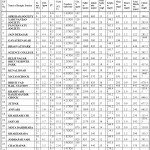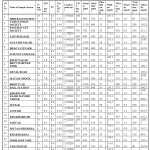Physicochemical Analysis of Bore-Wells Drinking Water in Morbi-Malia Territor
B.M. Bheshdadia, D.S. Kundariya and P.K. Patel
Department of Chemistry, M. M. Science College, Morbi - 363 642, Saurashtra University, Rajkot, Gujarat, India.
Physico-chemical analysis such as temperature, salinity, alkalinity, total hardness, phosphate, sulphate, nitrate, pH, electrical conductivity, T.D.S., turbidity, dissolved oxygen, fluoride, chloride of bore-well water was carried out from twenty five sampling stations of Morbi-Malia territory during May-2009 (before monsoon) and October-2009 (after monsoon) in order to assess water quality index.
KEYWORDS:Physico-chemical analysis; Bore-well drinking water; Morbi-Malia; Gujarat.
Download this article as:| Copy the following to cite this article: Bheshdadia B. M, Kundariya D. S, Patel P. K. Physicochemical Analysis of Bore-Wells Drinking Water in Morbi-Malia Territor. Orient J Chem 2011;27(2). |
| Copy the following to cite this URL: Bheshdadia B. M, Kundariya D. S, Patel P. K. Physicochemical Analysis of Bore-Wells Drinking Water in Morbi-Malia Territor. Available from: http://www.orientjchem.org/?p=24972 |
Introduction
In continuation of earlier studies on bore-well water1-3, here we have investigated intensively the Physico-Chemical analysis of drinking water of Morbi-Malia territory, located in Rajkot district of Gujarat state. Bore-well water is generally used for drinking and other domestic purposes in this area. The use of fertilizers and pesticides, manure, lime, septic tank, refuse dump etc. is the major sources of bore-well water pollution4. In the absence of fresh water supply people residing in this area use bore-well water for their domestic and drinking purpose. In order to assess water quality index, we have conducted the physico-chemical analysis of bore-well drinking water.
Experimental
In the present study bore-well water samples from twenty five different areas located in and around Morbi-Malia territory were collected in brown glass bottle with necessary precautions5.
All the chemicals were used of AR grade. Double distilled water was used for the preparation of reagents and solution. The major water quality parameters considered for the examination in this study are temperature, pH, D.O., turbidity, electrical conductivity, T.D.S., salinity, alkalinity, phosphate, sulphate, nitrate, fluoride, total hardness and chloride contents6.
Temperature, pH, D.O., turbidity, electrical conductivity, T.D.S., salinity, phosphate, nitrate and fluoride value were measured by water analysis kit, portable D.O. meter and manual methods. Total hardness of water was estimated by complexometric titration methods7. Chloride content was determined volumetrically by silver nitrate titrimetric method using potassium chromate as an indicator and was calculated in terms of mg/l. Alkalinity of water samples were measured volumetrically by titrimetric method7. Sulphate content was determined by volumetric method7.
Results And Discussion
Temperature : In the present study, temperature in May-2009 ranged from 29.8 to32.80C and temperature in October-2009 ranged from 29.0 to 31.70C.
D.O. : In the present study, D.O. in May-2009 ranged from 3.7 to 7.3 ppm. The minimum tolerance range is 4.0 ppm for drinking water. But the D. O. was found lower in sample station Nos. 1 and 8. In October-2009 D.O. ranged from 3.9 to 8.1 ppm. But the sample station No. 1 showed lower range.
pH : In the present study, pH in May-2009 ranged from 7.09 to 8.89. The tolerance pH limit8 is 6.5 to 8.5. The sample station No. 1, 3, 5, 6, 8, 11, 12, 13, 15, 16, 17, 21, 23, 24 and 25 showed higher pH than prescribed range. In October-2009 pH ranged from 7.58 to 9.06. The sample station No. 8, 12, 15, 16, 17, 20, 21 and 23 showed higher pH than the prescribed range.
Turbidity : In the present study, Turbidity in May-2009 ranged from 0.06 to 2.50 NTU and in October-2009 Turbidity ranged from 0.10 to 4.70.The tolerance range for Turbidity is 5 NTU10. So all the sample station Nos. have shown lower NTU values than the prescribed range.
Electrical conductance : In present study, Electrical conductance in May-2009 ranged from 0.78 x 10-3 to 6.10 x 10-3 mho/cm, while in October-2009 Electrical conductance ranged from 0.47 x 10-3 to 4.94 x 10-3 mho/cm.
T.D.S. : In the present study, TDS in May-2009 ranged from 397 to 3090 ppm. According to WHO9 and Indian standards10, TDS value should be less than 500 ppm for drinking water. The sample station Nos. 1 to 25 except 10 showed higher ranges compare to prescribed WHO and Indian standards. In October-2009 TDS ranged from 237 to 2490 ppm. But sample station Nos. 1 to 25 except 7, 10, 20 and 21 showed higher range than prescribed range.
Salinity : In the present study, Salinity in May-2009 ranged from 390 to 3080 ppm and in October-2009 Salinity ranged from 240 to 2470 ppm.
Alkalinity : In the present study, Alkalinity in May-2009 ranged from 100 to 660 ppm while in October-2009 Alkalinity ranged from 120 to 700 ppm.
Phosphate : In the present study, Phosphate in May-2009 ranged from 11 to 42 mg/l and in October-2009 Phosphate ranged from 10 to 31 mg/l. The evaluated value of phosphate in the present study is higher than the prescribed value13. The higher value of phosphate is mainly due to the use of fertilizers and pesticides by the people residing in this area. If phosphate is consumed in excess, phosphine gas is produced in gastro-intestinal tract on reaction with gastric.
Nitrate : In the present study, Nitrate in May-2009 ranged from 84 to 447 mg/l and in October-2009 Nitrate ranged from 90 to 415 mg/l. The tolerance range for Nitrate is 20-45 mg/l. Nitrate nitrogen is one of the major constituents of organism along with carbon and hydrogen as amino acids proteins and organic compounds in the bore-well water14. If the nitrate reduces to nitrite then it causes methaemoglobinaemia in infants15,16 and also diarrhea.
Sulphate : In the present study, Sulphate in May-2009 ranged from 125.29 to 365.08 mg/l and in October-2009 Sulphate ranged from 105.15 to 355.08 mg/l. The tolerance range of Sulphate is 200-400 mg/l12.
Total hardness : In the presence study, Total hardness in May-2009 ranged from 110 to 980 ppm and in October-2009 Total hardness ranged from 80 to 810 ppm. The tolerance range for Total hardness11 is 300-600 ppm.
Chloride : In the present study, Chloride in May-2009 ranged from 120.2 to 1469.7 mg/l and in October-2009 Chloride ranged from 63.9 to 1180.9 mg/l. While the tolerance range for chloride is 200-1000 mg/l10.
Fluoride : In the present study, Fluoride in May-2009 ranged from 0.9 to 1.2 mg/l and in October-2009 Fluoride ranged from 0.9 to 1.2 mg/l. While the tolerance range for Fluoride is 1.0 to 1.5 mg/l10.
Acknowledgement
The Principle Investigator is thankful to UGC for financial assistance in the form of Minor Research Project [F No. 47-550/08 (WRO) Dated:-15/01/2009]. The Principle Investigator is also thankful to The Sarvodaya Education Society, Morbi and the Principal, M.M.ScienceCollege, Morbi, for providing necessary facilities.
 |
Table 1: Analysis Result Of The Samples Collacted From Morbi-Malia Territory In May – 2009 Click here to View table |
 |
Table 2: Analysis Result of the Samples Collacted from Morbi-Malia Territory in Oct – 2009 Click here to View table |
References
- A.K. Rana, M.J. Kharodawala, J. M. Patel, R.K. Rai, B.S. Patel and Dabhi, Asian J.Chem., 14, 1209 (2002).
- A.K. Rana, M.J. Kharodawala, H.R. Dabhi, D.M. Suthar, D.N. Dave, B.S. Patel and R.K. Rai, Asian J. Chem., 14, 1178 (2002).
- D.K. Bhoi, D.S. Raj, Y.M. Mehta, M.B. Chauhan and M.T.Machhar, Asian J.Chem., 17, 404 (2005).
- P.A. Hamilton and D.K. Helsel, Ground Water, 33, 2 (1995)
- E. Broun, M.W. Skovgstd and M.J. Fishman, Method for Collection and Analysis of water Samples for Dissplved Minerals andGases, Vol.5 (1974)
- N. Manivasagam, Physico-chemical Examination of water, Sewage And Industrial Effluents, Pragati Prakashan, Meerut (1984).
- A.I. Vogel, Text Book of Quantitative, Inorganic Analysis, 4th Edn., ELBC, London (1978).
- APHA: American Public Health Association, Standard Methods for Examinnation of water and Wastewater, 16th Edn., APHA-WPCF-AWWA, Washington (1985).
- International Standard for Drinking Water, 3rd Edn., WHO, Geneva (1971).
- The Gazette of India: Extraordinary, Part-II, 3, 11 (1991).
- A.J. Dhembare, G.M. Pondhe and C.R. Singh, poll. Res., 17, 87 (1998).
- J.E. Mekee and H.W. Wolf, Water Quality Criteria. The Resources Agency of Californina State Water Quality Control Board (1978).
- APSFSL, Andhra Pradesh State Forensic Science Laboratories, Annual Report (1988).
- D.G. Miller, Nitrate in Drinking Water, Water Research Centre, Medmenham (1981).
- NEERI: National Environment Engineering Research Institute, Disinfection of SmallCommunity Water Supplies, Nagpur (1972).
- J.W. White, J.Agri. Food Chem., 23, 886 (1975).

This work is licensed under a Creative Commons Attribution 4.0 International License.









